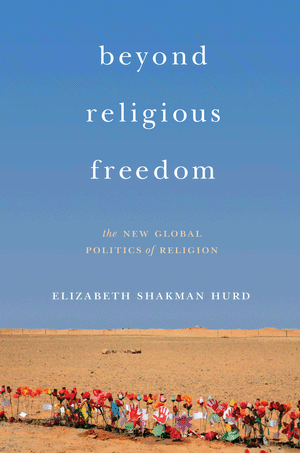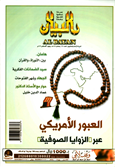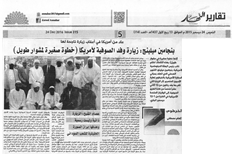 In the summer of 2013, the international Islamic magazine al-Bayan1My sincere thanks to Muhammad Khalifa Siddiq who brought to my attention both this article from al-Bayan and the article about the Sufi delegation to the United States that I discuss below. published its Ramadan issue with a striking cover. Flanked by titles on the Qur’anic and Biblical figure Haman, jihad and the great battles won by Muslims in the month of Ramadan, and an interview with the Iraqi Islamist intellectual ‘Imad al-Din Khalil, the image that the editors chose for the cover article was clearly meant to cause controversy. Casually strewn across a map of the Middle East and North Africa was a simple sibha, a chain of beads used to count repetitive prayers known collectively as adhkar. In recent years, the sibha has come to be associated as a marker of Sufi Mulims, given that non-Sufi reformist Muslims of various stripes have stipulated that it constitutes an innovation in worship and thus a straying from the perfect path laid down by the Prophet himself for praising God. Attached to the end of this sibha, where a bead or other decoration might normally be located, was a small American flag, resembling those lapel pins that US government officials began to wear following 9/11. If the implications of the image itself were not clear, the headline on which it sat most certainly was: “American Infiltration through the Sufi zawiyas.”2Zawiyas are sites for collective Sufi ritual performance.
In the summer of 2013, the international Islamic magazine al-Bayan1My sincere thanks to Muhammad Khalifa Siddiq who brought to my attention both this article from al-Bayan and the article about the Sufi delegation to the United States that I discuss below. published its Ramadan issue with a striking cover. Flanked by titles on the Qur’anic and Biblical figure Haman, jihad and the great battles won by Muslims in the month of Ramadan, and an interview with the Iraqi Islamist intellectual ‘Imad al-Din Khalil, the image that the editors chose for the cover article was clearly meant to cause controversy. Casually strewn across a map of the Middle East and North Africa was a simple sibha, a chain of beads used to count repetitive prayers known collectively as adhkar. In recent years, the sibha has come to be associated as a marker of Sufi Mulims, given that non-Sufi reformist Muslims of various stripes have stipulated that it constitutes an innovation in worship and thus a straying from the perfect path laid down by the Prophet himself for praising God. Attached to the end of this sibha, where a bead or other decoration might normally be located, was a small American flag, resembling those lapel pins that US government officials began to wear following 9/11. If the implications of the image itself were not clear, the headline on which it sat most certainly was: “American Infiltration through the Sufi zawiyas.”2Zawiyas are sites for collective Sufi ritual performance.

The article cites several US policy think tanks that argued in reports throughout the early 2000s that there is a strategic interest in partnering with Sufi organizations in the Islamic world as a means of countering Islamic radicalism: from the Rand Corporation, to the Nixon Center (now renamed the Center for National Interest), to the US Institute for Peace. The article then speculates that at least some of these recommendations have in fact become policy, citing everything from efforts of US embassies to make links with Sufi leadership to cultural support by western aid agencies for the rebuilding of Sufi holy sites. Its authors write:
The cause of this great interest in Sufism…is the American search for a partner inside the body of the Muslim umma through which it can implement a strategy to disrupt and expel the Salafi trends that stand as a stumbling block in the path of its dominance over the Muslims and its bid to oust Islam from their lives.
* * *
Elizabeth Shakman Hurd’s Beyond Religious Freedom: The New Global Politics of Religion suggests that there may be more to the al-Bayan article than merely an attempt to denigrate an age-old religious rival or a paranoia about US meddling into Muslim affairs. Through a comprehensive recounting of projects by, among others, USAID, the US military and its chaplaincy, and the Department of Homeland Security, Hurd’s book is a snapshot of a very distinct—though not entirely unprecedented—moment in US (and European) engagement with the world in which “transforming religions to be better versions of themselves” has become a major policy objective. While religion was previously thought of in government circles as epiphenomenal to foreign affairs (or off-limits due western secular perogatives) it has, in our postsecular policy age, been crowned with agency, a salve for internecine strife as much as it has been the cause thereof. Countless projects have ensued to isolate people assumed to be motivated primarily by this force (who are called “religious actors”) and to use them to help spark religious reform in their own countries, under monikers such as “Countering Violent Extremism” (CVE)3My thanks to Anver Emon who pointed out to me a whole cottage-industry around this acronym. here in the US, or discourses such as Tony Blair’s “Two Faces of Faith,” which Hurd outlines in Chapter 2. Hurd reveals to us the dangerous consequences of these projects, arguing that they have led to “construals of religious difference to support new forms of exclusionary nationalisms,” as countries from Myanmar to Egypt have latched onto the global discourse of “good and bad religion” to reframe internal political struggles, often distracting attention from much more complicated and sedimented histories of marginalization.
In my own work, I have discussed an attempt approximately 100 years ago by the British to stamp out Islamic “fanaticism” in Sudan that shares many similarities with the twenty-first century projects of differentiating between “good and bad religion” that Hurd discusses in her book. However, in the early twentieth century Sudanese case, the fanatics and the moderates were deemed the precise opposites of what they are today: the former being the Sufis the west has now come to embrace, the latter the kind of scholastic reformist Muslims who are today seen as the origins of extremism. These opposite valuations do not indicate that something has changed about Sufism (though, of course, much has), but that what has changed is the West and its particular agendas in the Islamic world that have caused Sufism to shift from irrational “fanaticism,” in the twentieth century imaginary, to “tolerant Islam,” in the twenty-first. While the study of the intersection of religion and violence has long focused on the “religious causes” of war, far less attention has been placed on how new forms of religion are produced through the means of conflict and post-conflict reconstruction. Such a phenomenon is observable in both cases, whether it be the “ordered scholastic Islam” of the twentieth century the British attempted to import from Egypt to Sudan in order to overcome what they misconstrued as decentralized and ecstatic modes of Sufi authority or the “liberal Islam” of today that western powers are encouraging through embracing Sufis as a more tolerant and potentially apolitical Islam in an era of growing “Islamic radicalism.” Whether these projects are undertaken in order to foster social stability, aid in the governing of diversity, or ensure global (or local) order, religion appears here as a product born out of violent political conflict. Hurd’s book prompts us to ask: what would it mean to understand religion not as a pre-existing force that motivates violence (for violence always is motivated by a complex matrix of concerns never reducible to the theological), but rather as something that is produced through violence as part of a governing strategy or as an attempt to resist that strategy? Hurd reminds us that, “As global ecologies of affiliation based on religious-religious and religious-secular distinctions are disseminated and normalized, individuals and groups in search of international backing are prompted to articulate claims for resources, justice and dignity in terms that reflect and reinforce those distinctions.” Since new global orders require new religious forms to serve them, religions must modify themselves to be sustained in such orders. But what do such modifications look like on the ground, and how have they changed what it means to be religious and to confront religious difference in the contexts in question?
For scholars of Islam, it seems worth exploring not only these US endeavors to create a “moderate Islam,” but other questions as well. What are the diverse forces that have, for example, led Sufism in the post-9/11 world to become “liberal Islam” not just in the American imaginary (searching for “good Muslims,” local partners against Islamic extremism), but among Sufi actors themselves, who have retooled their public presentation to assume a role within a struggle with both global and local implications? What do the key categories of liberalism (tolerance, human rights, secular politics) that some Sufis are coming to embrace mean for Sufism’s own categories of organizing social and political life? And what resources for conflict resolution are lost when Sufis come to assimilate the categories of moderate versus extremist Islam in its rendering by western powers?4It is worth noting that Islamic thinkers have been speaking in terms of moderation (i’tidal) and extremism (tashaddud, ghulu) for centuries, but with very different sorts of valuations of those terms than they have today, see e.g. Sherman Jackson. 2002. On the Boundaries of Theological Tolerance in Islam: Abu Hamid al-Ghazali’s faysal al-tafriqa bayna al-islam wa al-zandaqa. Oxford: Oxford University Press and Alladin M. Yaqub, 2015. Al-Ghazali’s Moderation in Belief: al-iqtisad fi al-‘itiqad. Chicago: University of Chicago Press.
Hurd further prompts us to ask in what ways the engagement with “good Muslims” is leading to “a politics defined by religious difference” with potentially dangerous implications for already fractured societies in the Islamic world. The al-Bayan article gives a hint of the reaction that such engagement might inspire and thus allows us to see, at least briefly, a view from the other side of the phenomenon that Hurd discusses in her book. While her book focuses primarily on policy, it leaves open to the researcher the task of seeing how such policies are being consumed. Self-identifying with the Salafis (who are often viewed as extremists in the west), the al-Bayan article gives us a sense of this, offering a last ditch olive branch to the Sufis to join forces with them before utter chaos erupts in the Muslim world. The authors write ominously:
It is necessary to stress that the Sufis as an Islamic entity should be concerned, before anyone else, with facing this American project that tries to infiltrate them and work from inside their organizations to strike Islam. [Such a project], forces [Sufis] into an uncharted set of struggles with Salafis, whose results are yet unknown.
* * *

This past December, during a short visit to Khartoum, a good friend who is a rising star in the world of madih (religious song/poetry) performance invited me and my family to a late night neighborhood party to commemorate the conclusion of the celebration of the birthday of the Prophet. As normally occurs for foreign visitors, the organizers of the event seated my family and me right up front. It was to my great surprise, however, when I heard my name announced from the stage: “We want to thank Mr. Noah from Washington for coming to our gathering and the Americans who brought a delegation of Sufi leaders to their country.” Indeed, I had learned in Sudan that just that past week a delegation of Sufi shaykhs had returned from a two week journey to the United States. The delegation was sponsored by a local businessman (seemingly eager to change the perception of Sudan among Americans and chip away at the kind of public perception of Sudan that has kept it on international sanctions lists since the mid-1990s) and organized by the US Embassy in Khartoum. Search as I did in the US media and US government websites, I could find no mention of the visit, but the news was widely known in Khartoum, and deemed quite remarkable, given that official relations between the US and Sudan remain strained. An article in a Sudanese daily that followed the delegation’s return to Sudan and the press conference that was held at the US Embassy thereafter quoted the participants as stressing that this visit was a “people-to-people” exchange, though they did so enough times that it ceased to distract from the fact that the visit had been had been organized by the US Embassy (who are only “the people,” of course, in a very generous reading of “we the people”). Precisely what the agenda had been was not clear to me (perhaps simply “to learn about life in a ‘religiously tolerant’ country,” as Hurd describes the travels of a similar delegation?). Yet, in his statement at the press conference, Deputy Head of Mission at the US Embassy Benjamin Moeling does give us a clue of what it may have been. Clearly sensitive to how this visit might look to the Sudanese public, he assured the audience that this invitation does not constitute the support of the US government of one religious sect over another and that the US government simply “fights against extremism and terrorism” of any sort. But his logic here is hard to follow, given that he has clearly divided between extreme and moderate Muslims in choosing Sufi guests in particular to go on this journey. Indeed, according to the article, he told the audience that the US government invited the Sufis because it “discovered that the Sufis have an influence over the Sudanese people and that they have a desire for peace and that they represent moderate Islam (al-islam al-wasati).”
With once unheard of violence between Sufi and Salafi groups in Sudan now occurring regularly at the annual birthday celebrations for the Prophet Muhammad (in which the Sufis revel and the Salafis see a kind of idolatry), one wonders what the effect of collapsing Sufis with US intervention—as the al-Bayan article does, and as news of the visit of the Sufi delegation to the US in an otherwise sanctioned country might lend itself to doing—will be. What happens when Sufis come to stand in for an American proxy, when the Americans themselves are so out of reach? This is a question we must also ask of Mali, when among the first objects to be attacked in Timbuktu on its occupation by Ansar al-Din in 2012 were those sites that were both Sufi and classified as UNESCO World Heritage sites, a message that clearly had more than one intended recipient.5An al-Jazeera report wrote: “On Tuesday a source in Ansar Dine told the AFP news agency that ‘from now on, as soon as foreigners speak of Timbuktu’ they would attack anything referred to as a World Heritage site. ‘There is no world heritage, it doesn’t exist. The infidels must not get involved in our business,’ said a Tunisian who gave his name only as Ahmed and said he was part of Ansar Dine’s ‘media committee.’” While anti-Sufi rhetoric has existed since time immemorial, might the internationalization of these sites within inter-government projects explain why it was only now that they were destroyed?
One might rightly point out that, regardless of our interventions, religious identity in Sudan, as elsewhere, is already deeply politicized. Indeed, one might argue that the distinction between a religion and a way of life lies precisely in the ability to represent itself to a governing power, one that has attempted to carve out a domain exclusive to itself. As Hurd reminds us, cautioning against a reading of her book that would misconstrue its “beyond” as a desire for an unadulterated secular future:
There is no religion anywhere without government involvement in some form. Religion never left public life. Instead it has assumed different forms and occupied different spaces under modern regimes of governance, many of which are described as secular….The question is how these entanglements between governments and individuals and institutions abroad take shape: who gets chosen and why? How are they identified and by whom? Which versions of which religions are supported? Which religious authorities are privileged, and who exactly are they understood to represent?
Thus, what reading the view from the other side implores us to strive for is not a fantasy of religion before politics, nor, for that matter, a politics beyond religion, but rather a deep accounting of our own place in the discord that has come to define the Islamic world, evidenced most clearly in our fitful attempts to resolve it through reforming religion.











